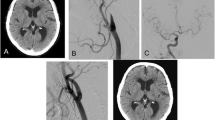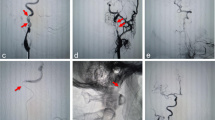Abstract
Acute ischemic stroke attributable to cervical internal carotid artery (ICA) occlusion is frequently associated with severe disability or death and is usually caused by atherosclerosis. By contrast, the cardioembolic cervical ICA occlusion is rare, and feasibility of urgent recanalization remains unclear. We present the first study in the literature that focuses on urgent open embolectomy for the treatment of cardioembolic cervical ICA occlusion. A retrospective review of the charts for patients undergoing open embolectomy was performed. Between April 2006 and September 2007, 640 consecutive patients with acute ischemic stroke were treated. Of them, three patients (0.47%) with the acute complete cardioembolic cervical ICA occlusion underwent urgent open embolectomy. All patients presented with profound neurological deficits and atrial fibrillation. The urgent open embolectomy achieved complete recanalization in all patients without any complications. All emboli in three patients were very large and fibrinous in histological findings. Two of three patients showed rapid improvement in neurological functions after surgical treatments. The cardioembolic occlusion of the cervical ICA is rare, but its possibility should be considered in patients with acute ischemic stroke suffering profound neurological deficits and atrial fibrillation. Urgent open embolectomy may be a treatment option to obtain successful recanalization for cardioembolic cervical ICA occlusion and is recommended because it is technically easier and similar to carotid endarterectomy.





Similar content being viewed by others
References
Adams HP Jr, Bendixen BH, Leira E, Chang KC, Davis PH, Woolson RF, Clarke WR, Hansen MD (1999) Antithrombotic treatment of ischemic stroke among patients with occlusion or severe stenosis of the internal carotid artery: a report of the Trial of Org 10172 in Acute Stroke Treatment (TOAST). Neurology 53:122–125
Christou I, Felberg RA, Demchuk AM, Burgin WS, Malkoff M, Grotta JC, Alexandrov AV (2002) Intravenous tissue plasminogen activator and flow improvement in acute ischemic stroke patients with internal carotid artery occlusion. J Neuroimaging 12:119–122
Derdeyn CP, Grubb RL Jr, Powers WJ (1999) Cerebral hemodynamic impairment: methods of measurement and association with stroke risk. Neurology 53:251–259
Ferro JM (2003) Cardioembolic stroke: an update. Lancet Neurol 2:177–188
Furlan A, Higashida R, Wechsler L, Gent M, Rowley H, Kase C, Pessin M, Ahuja A, Callahan F, Clark WM, Silver F, Rivera F (1999) Intra-arterial prourokinase for acute ischemic stroke. The PROACT II study: a randomized controlled trial. Prolyse in Acute Cerebral Thromboembolism. JAMA 282:2003–2011
Horiuchi T, Nitta J, Sakai K, Tanaka Y, Hongo K (2007) Emergency embolectomy for treatment of acute middle cerebral artery occlusion. J Neurosurg 106:257–262
Jovin TG, Gupta R, Uchino K, Jungreis CA, Wechsler LR, Hammer MD, Tayal A, Horowitz MB (2005) Emergent stenting of extracranial internal carotid artery occlusion in acute stroke has a high revascularization rate. Stroke 36:2426–2430
Kasper GC, Wladis AR, Lohr JM, Roedersheimer LR, Reed RL, Miller TJ, Welling RE (2001) Carotid thromboendarterectomy for recent total occlusion of the internal carotid artery. J Vasc Surg 33:242–250
Lammie GA, Sandercock PAG, Dennis MS (1999) Recently occluded intracranial and extracranial carotid arteries. Relevance of the unstable atherosclerotic plaque. Stroke 30:1319–1325
Marder VJ, Chute DJ, Starkman S, Abolian AM, Kidwell C, Liebeskind D, Ovbiagele B, Vinuela F, Duckwiler G, Jahan R, Vespa PM, Selco S, Rajajee V, Kim D, Sanossian N, Saver JL (2006) Analysis of thrombi retrieved from cerebral arteries of patients with acute ischemic stroke. Stroke 37:2086–2093
McBabe RD, Hodge DO, Wysokinski WE (2008) Clinical and echocardiographic measures governing thromboembolism destination in atrial fibrillation. Thromb Haemost 99:951–955
McCormick PW, Spetzler RF, Bailes JE, Zabramski JM, Frey JL (1992) Thromboendarterectomy of the symptomatic occluded internal carotid artery. J Neurosurg 76:752–758
Meyer FB, Sundt TM Jr, Piepgras DG, Sandok BA, Forbes G (1986) Emergency carotid endarterectomy for patients with acute carotid occlusion and profound neurological deficits. Ann Surg 203:82–89
Sakai K, Nitta J, Horiuchi T, Ogiwara T, Kobayashi S, Tanaka Y, Hongo K (2008) Emergency revascularization for acute main-trunk occlusion in the anterior circulation. Neurosurg Rev 31:69–76
Smith WS, Sung G, Saver J, Budzik R, Duckwiler G, Liebeskind DS, Lutsep HL, Rymer MM, Higashida RT, Starkman S, Gobin YP, Frei D, Grobelny T, Hellinger F, Huddle D, Kidwell C, Koroshetz W, Marks M, Nesbit G, Silverman IE, Multi MERCI Investigators (2008) Mechanical thrombectomy for acute ischemic stroke: final results of the Multi MERCI trial. Stroke 39:1205–1212
Spearman MP, Jungreis CA, Wechsler LR (1995) Angioplasty of the occluded internal carotid artery. AJNR Am J Neuroradiol 16:1791–1796
The National Institute of Neurological Disorders and Stroke t-PA Stroke Study Group (1995) Tissue plasminogen activator for acute ischemic stroke. N Engl J Med 333:1581–1587
Walters BB, Ojemann RG, Heros RC (1987) Emergency carotid endarterectomy. J Neurosurg 66:817–823
Yasaka M, Omae T, Tsuchiya T, Yamaguchi T (1992) Ultrasonic evaluation of the site of carotid axis occlusion in patients with acute cardioembolic stroke. Stroke 23:420–422
Yuan C, Mitsumori LM, Beach KW, Maravilla KR (2001) Carotid atherosclerotic plaque: noninvasive MR characterization and identification of vulnerable lesions. Radiology 221:285–299
Zivin JA, Fisher M, DeGirolami U, Hemenway CC, Stashak JA (1985) Tissue plasminogen activator reduces neurological damage after cerebral embolism. Science 230:1289–1292
Author information
Authors and Affiliations
Corresponding author
Additional information
Comments
Taketo Hatano, Kyoto, Japan
Murata et al. present three patients who underwent microsurgical revascularization for cardioembolic occlusion of the cervical internal carotid artery. The occluded arteries were re-canalized completely without any complications. This is the first report to describe in detail the technique and results of an emergency open embolectomy for cardioembolic ICA occlusion. This report highlights a microsurgical embolectomy as a potentially effective treatment for cardioembolic ICA occlusion. The effectiveness and the risk of this treatment mainly depend on the collateral flow and the time to re-canalization. Therefore, the authors suggest that stricter patient selection criteria, including the evaluation of the cerebral blood flow, may be necessary. One of the disadvantages of an open embolectomy is that it takes a relatively long time to prepare and perform the procedure (the mean admission-to-re-canalization time was 4 hours 30 minutes at the authors’ institution). Recently, endovascular treatments with various techniques and devices, has also become an alternative treatment for these lesions. Therefore, although I endorse the necessity to perform aggressive treatment for cervical internal carotid artery occlusion with serious or progressing neurological symptoms, further study should be undertaken to clarify the effectiveness of performing a direct embolectomy and endovascular treatment.
Christopher M. Loftus. Philadelphia, USA
Murata et al., from Shinshu University, have tremendous experience with stroke, carotid disease, and carotid reconstruction. In this excellent report, they discuss three cases (out of 640 retrospectively screened chart files) where carotid occlusion was caused by a cardiogenic embolus that lodged at the carotid bifurcation. In their three surgical cases all patients did well, most likely because of strict selection criteria, skilled surgery, and careful management.
As I review this scholarly contribution there remain several unanswered questions for me. First, it seems difficult that the surgeons can ascertain preoperatively whether the carotid occlusions were from a cardiogenic source. The angiographic images just show complete occlusion, which in my mind could develop from atheromatous disease and plaque rupture, and of course floating thrombus can form from atheromatous disease as well. The fibrinous nature of the clot, once it has been removed, suggests a cardiac origin, but I am not certain that this can be determined before surgical exploration, except perhaps by inference in patients with known atrial fibrillation and known cardiac atrial thrombi.
This is an interesting academic distinction, but it doesn’t really affect clinical decision making. The most important contribution from this paper is that an extremely rare phenomenon, cervical carotid occlusion from cardiac thrombus, has been beautifully studied and documented, that large emboli originating from cardiac origin can lodge at the carotid bifurcation and threaten stroke, and that well-selected patients can make good recoveries from a simple exploration. It is unclear whether other potential interventions, such as TPA or mechanical endovascular retrieval, could be as effective or as rapid as surgery in reversing stroke-like symptoms. I suspect they would not be as good.
The real message for surgeons here is that acute carotid occlusion, no matter what the cause, is a surgical disease, and that selected patients can have favorable outcomes from an aggressive approach to diagnosis, imaging, and surgical intervention.
I congratulate these authors for their rigorous analysis and their valuable contribution to our understanding of the broad spectrum of carotid disease.
Rights and permissions
About this article
Cite this article
Murata, T., Horiuchi, T., Nitta, J. et al. Urgent open embolectomy for cardioembolic cervical internal carotid artery occlusion. Neurosurg Rev 33, 341–348 (2010). https://doi.org/10.1007/s10143-010-0252-y
Received:
Revised:
Accepted:
Published:
Issue Date:
DOI: https://doi.org/10.1007/s10143-010-0252-y




